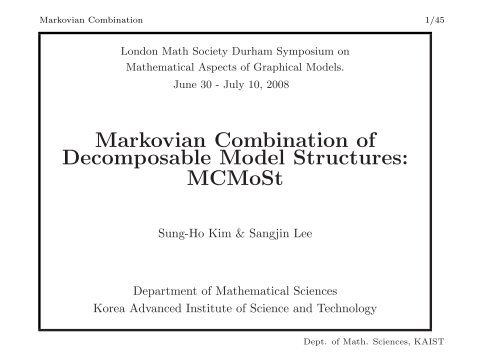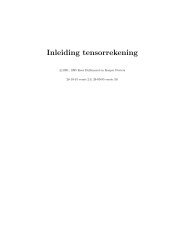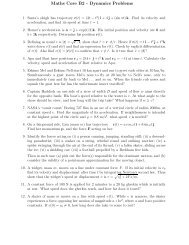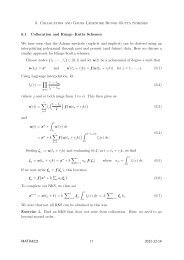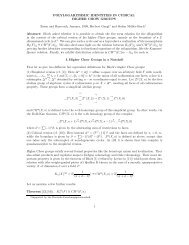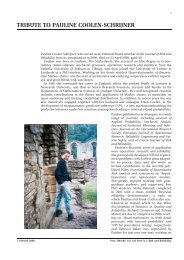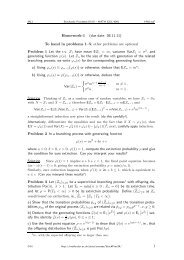Markovian Combination of Decomposable Model Structures: MCMoSt
Markovian Combination of Decomposable Model Structures: MCMoSt
Markovian Combination of Decomposable Model Structures: MCMoSt
You also want an ePaper? Increase the reach of your titles
YUMPU automatically turns print PDFs into web optimized ePapers that Google loves.
<strong>Markovian</strong> <strong>Combination</strong> 1/45<br />
London Math Society Durham Symposium on<br />
Mathematical Aspects <strong>of</strong> Graphical <strong>Model</strong>s.<br />
June 30 - July 10, 2008<br />
<strong>Markovian</strong> <strong>Combination</strong> <strong>of</strong><br />
<strong>Decomposable</strong> <strong>Model</strong> <strong>Structures</strong>:<br />
<strong>MCMoSt</strong><br />
Sung-Ho Kim & Sangjin Lee<br />
Department <strong>of</strong> Mathematical Sciences<br />
Korea Advanced Institute <strong>of</strong> Science and Technology<br />
Dept. <strong>of</strong> Math. Sciences, KAIST
<strong>Markovian</strong> <strong>Combination</strong> 2/45<br />
Contents<br />
1 Introduction<br />
2 Preliminaries<br />
3 Distribution, interaction graph, and <strong>Markovian</strong><br />
subgraph<br />
4 Combined model structures<br />
5 Graph <strong>of</strong> prime separators (GOPS)<br />
6 Algorithm<br />
7 Time complexity<br />
8 Illustration-1<br />
9 Illustration-2<br />
10 Concluding remarks<br />
11 Where to go?<br />
Dept. <strong>of</strong> Math. Sciences, KAIST
<strong>Markovian</strong> <strong>Combination</strong> 3/45<br />
1 Introduction<br />
• Problem and motivation<br />
1. Consider a problem <strong>of</strong> developing a graphical model <strong>of</strong><br />
30 item score variables (X’s) and 20 or more<br />
cognitive/knowledge state variables (U’s).<br />
2. We use the model for diagnosing knowledge states<br />
where knowledge states are predicted via conditional<br />
probabilities.<br />
3. X’s are observable and U’s are not, and assume they<br />
are all binary.<br />
4. Cognitive diagnosis and model structure<br />
Dept. <strong>of</strong> Math. Sciences, KAIST
<strong>Markovian</strong> <strong>Combination</strong> 4/45<br />
• Two common sense issues in large-scale modeling:<br />
1. Sparseness <strong>of</strong> data (Koehler, 1986; Maydeu-Olivares<br />
and Joe, 2005; Kim(in revision))<br />
2. <strong>Model</strong>/time complexity (Chickering, 1996)<br />
- Koehler, K.J., 1986. Goodness-<strong>of</strong>-fit tests for log-linear models in<br />
sparse contingency tables. JASA, 81(394), 483-493.<br />
- Maydeu-Olivares, A., Joe, H., 2005. Limited- and full-information<br />
estimation and goodness-<strong>of</strong> -fit testing in 2 n contingency tables: a<br />
unified framework. JASA, 100(471), 1009-1020.<br />
- Chickering, D. (1996). Learning Bayesian networks is<br />
NP-complete, In: Learning from Data, D. Fisher and H. Lenz (Ed.),<br />
121-130, Springer-Verlag.<br />
- Kim (in revision). Estimate-based goodness-<strong>of</strong>-fit test for large<br />
sparse multinomial distributions.<br />
Dept. <strong>of</strong> Math. Sciences, KAIST
<strong>Markovian</strong> <strong>Combination</strong> 5/45<br />
• Fienberg and Kim (1999) and Kim (2006) considered a<br />
problem <strong>of</strong> combining conditional graphical log-linear<br />
structures and derived a combining rule for them based on<br />
the relation between the log-linear model and its<br />
conditional version.<br />
• A main feature <strong>of</strong> the relation is that conditional<br />
log-linear structures appear as parts <strong>of</strong> their joint model<br />
structure [Theorems 3 and 4, Fienberg and Kim].<br />
- Fienberg and Kim (1999). Combining conditional log-linear<br />
structures, JASA, 445(94), 229-239.<br />
- Kim (2006). Conditional log-linear structures for log-linear<br />
modelling, CSDA, 50(8), 2044-2064.<br />
Dept. <strong>of</strong> Math. Sciences, KAIST
<strong>Markovian</strong> <strong>Combination</strong> 6/45<br />
But not between marginal and joint models!<br />
• Consider two marginal models, [12][23] and [12][24], which<br />
are possible from each <strong>of</strong><br />
[12][24][23], [12][24][34], [12][23][34], [12][234].<br />
• How can we find a joint model structure from a given<br />
set <strong>of</strong> marginal model structures?<br />
Dept. <strong>of</strong> Math. Sciences, KAIST
<strong>Markovian</strong> <strong>Combination</strong> 7/45<br />
2 Preliminaries<br />
• We will consider only undirected graphs.<br />
• For a subset A ⊆ V , we denote by GA = (A, EA) the<br />
subgraph <strong>of</strong> G = (V, E) confined to A where<br />
EA = (E ∩ A × A) ∪<br />
{(u, v) ∈ A × A; u and v are not separated by<br />
A \ {u, v} in G}.<br />
We will call GA the <strong>Markovian</strong> subgraph <strong>of</strong> G confined to<br />
A.<br />
2<br />
2<br />
1<br />
4 5<br />
3<br />
(a) (b)<br />
1<br />
3<br />
4<br />
Dept. <strong>of</strong> Math. Sciences, KAIST
<strong>Markovian</strong> <strong>Combination</strong> 8/45<br />
• If G = (V, E), G ′ = (V, E ′ ), and E ′ ⊆ E, then we say that G ′<br />
is an edge-subgraph <strong>of</strong> G and write G ′ ⊆ e G.<br />
• According to the definition <strong>of</strong> a decomposable graph, we<br />
can find a sequence <strong>of</strong> cliques C1, · · · , Ck <strong>of</strong> a decomposable<br />
graph G which satisfies the following condition [see<br />
Proposition 2.17 <strong>of</strong> Lauritzen (1996)]: with C (j) = ∪ j<br />
i=1 Ci<br />
and Sj = Cj ∩ C (j−1),<br />
for all i > 1, there is a j < i such that Si ⊆ Cj.<br />
• We denote the collection <strong>of</strong> these Sj’s by χ(G).<br />
- Lauritzen (1996). Graphical <strong>Model</strong>s. Oxford: Oxford University<br />
Press.<br />
Dept. <strong>of</strong> Math. Sciences, KAIST
<strong>Markovian</strong> <strong>Combination</strong> 9/45<br />
• The cliques are elementary graphical components and<br />
the Sj is obtained as intersection <strong>of</strong> neighboring cliques.<br />
We will call the Sj’s prime separators <strong>of</strong> the decomposable<br />
graph G.<br />
• Prime graphs are defined as the maximal subgraphs<br />
without a complete separator in Cox and Wermuth(1999).<br />
• The prime separators in a decomposable graph may be<br />
extended to separators <strong>of</strong> prime graphs in any undirected<br />
graph.<br />
- Cox, D.R. and Wermuth, N. (1999). Likelihood factorizations for<br />
mixed discrete and continuous variables, SJS, 26, 209-220.<br />
Dept. <strong>of</strong> Math. Sciences, KAIST
<strong>Markovian</strong> <strong>Combination</strong> 10/45<br />
• We will denote by M(G) the collection <strong>of</strong> the<br />
distributions that are globally Markov with respect to G,<br />
i.e., if, for three disjoint subsets A, B, C <strong>of</strong> V , XA and XB<br />
are conditionally independent given XC, then A and B are<br />
separated by C in G.<br />
Dept. <strong>of</strong> Math. Sciences, KAIST
<strong>Markovian</strong> <strong>Combination</strong> 11/45<br />
3 Distribution and interaction graphs<br />
• For a distribution P, let G(P) be the interaction graph <strong>of</strong><br />
P.<br />
Theorem 1. (Corollary 3.4 in Kim (2004)) For a distribution<br />
P <strong>of</strong> XV and A ⊆ V ,<br />
PA ∈ M(G(P)A).<br />
• For a collection V <strong>of</strong> subsets <strong>of</strong> V , let<br />
˜L(GA, A ∈ V) = {P; PA ∈ M(GA), A ∈ V}.<br />
Theorem 2. (Theorem 3.6 in Kim(2004)) For a collection V <strong>of</strong><br />
subsets <strong>of</strong> V with an undirected graph G,<br />
M(G) ⊆ ˜ L(GA, A ∈ V).<br />
- Kim (2004). Combining decomposable model structures, RR 04-15,<br />
Division <strong>of</strong> Applied Mathematics, KAIST.<br />
Dept. <strong>of</strong> Math. Sciences, KAIST
<strong>Markovian</strong> <strong>Combination</strong> 12/45<br />
4 Combined model structures<br />
• Let G = (V, E) be decomposable and let V1, V2, · · · , Vm be<br />
subsets <strong>of</strong> V . For simplicity, we write Gi = GVi.<br />
Definition 3. Suppose there are m <strong>Markovian</strong> subgraphs,<br />
G1, · · · , Gm. Then we say that graph H <strong>of</strong> a set <strong>of</strong> variables<br />
V is a combined model structure (CMS) corresponding to<br />
G1, · · · , Gm, if the following conditions hold:<br />
(i) ∪ m i=1 Vi = V.<br />
(ii) HVi = Gi, for i = 1, · · · , m. That is, Gi are <strong>Markovian</strong><br />
subgraphs <strong>of</strong> H.<br />
We will call H a maximal CMS corresponding to G1, · · · , Gm<br />
if adding any edge to H invalidates condition (ii) for at<br />
least one i = 1, · · · , m.<br />
Dept. <strong>of</strong> Math. Sciences, KAIST
<strong>Markovian</strong> <strong>Combination</strong> 13/45<br />
• Let CG(A) denote the collection <strong>of</strong> the cliques which<br />
include nodes <strong>of</strong> A in the graph G.<br />
Lemma 4. Let G ′ = (V ′ , E ′ ) be a <strong>Markovian</strong> subgraph <strong>of</strong> G<br />
and suppose that, for three disjoint subsets A, B, C <strong>of</strong> V ′ ,<br />
〈A|B|C〉G ′. Then<br />
(i) 〈A|B|C〉G;<br />
(ii) For W ∈ CG(A) and W ′ ∈ CG(C), 〈W |B|W ′ 〉G.<br />
Dept. <strong>of</strong> Math. Sciences, KAIST
<strong>Markovian</strong> <strong>Combination</strong> 14/45<br />
Theorem 5. (Kim, 2006) Let there be <strong>Markovian</strong> subgraphs<br />
Gi, i = 1, 2, · · · , m, <strong>of</strong> a decomposable graph G. Then<br />
(i) ∪ m i=1χ(Gi) ⊆ χ(G);<br />
(ii) for any maximal CMS H,<br />
∪ m i=1χ(Gi) = χ(H).<br />
Theorem 6 (Unique existence). (Kim, 2006) Suppose there are<br />
m <strong>Markovian</strong> subgraphs G1, · · · , Gm <strong>of</strong> a decomposable<br />
graph G. Then there exists a unique maximal CMS H ∗ <strong>of</strong><br />
the m <strong>Markovian</strong> subgraphs such that G ⊆ e H ∗ .<br />
- Kim. (2006). Properties <strong>of</strong> <strong>Markovian</strong> subgraphs <strong>of</strong> a<br />
decomposable graph, LNAI 4293, 15-26.<br />
Dept. <strong>of</strong> Math. Sciences, KAIST
<strong>Markovian</strong> <strong>Combination</strong> 15/45<br />
Theorem 7 (Invariance <strong>of</strong> PS). Let G be a decomposable<br />
graph and G1 and G2 be <strong>Markovian</strong> subgraphs <strong>of</strong> G.<br />
Suppose that a set C ∈ χ(G1) and that C ⊆ V2. Then C is<br />
not intersected in G2 by any other subset <strong>of</strong> V2.<br />
• We will call a node PS-node if it is a component <strong>of</strong> a<br />
PS; otherwise, a non-PS-node.<br />
Dept. <strong>of</strong> Math. Sciences, KAIST
<strong>Markovian</strong> <strong>Combination</strong> 16/45<br />
5 Graph <strong>of</strong> prime separators (GOPS)<br />
Definition 8. Let A = ∪ a∈χ(G)a. Then the graph <strong>of</strong> the<br />
prime separators (GOPS for short) <strong>of</strong> G is obtained from<br />
GA by replacing every PS and all the edges between every<br />
pair <strong>of</strong> neighboring PSs in GA with a node and an edge,<br />
respectively.<br />
1<br />
2<br />
12<br />
4<br />
3<br />
11<br />
8<br />
7<br />
5<br />
6<br />
3, 4<br />
3, 5<br />
4, 8 {11,12}<br />
Dept. <strong>of</strong> Math. Sciences, KAIST
<strong>Markovian</strong> <strong>Combination</strong> 17/45<br />
6 Algorithm<br />
[Separateness condition] Let M be a set <strong>of</strong> <strong>Markovian</strong><br />
subgraphs <strong>of</strong> G and H a maximal CMS <strong>of</strong> M. If two<br />
nodes are in a graph in M and they are not adjacent in<br />
the graph, then neither are they in H. Otherwise,<br />
adjacency <strong>of</strong> the nodes in H is determined by checking<br />
separateness <strong>of</strong> the nodes in M.<br />
Suppose that M consists <strong>of</strong> m <strong>Markovian</strong> subgraphs,<br />
G1, · · · , Gm, <strong>of</strong> G and we denote by a i a PS <strong>of</strong> Gi. We can<br />
then combine the models <strong>of</strong> M as follows.<br />
Step 1. We arrange the subgraphs into Gi1 , · · · , Gim such<br />
that |Vij ∩ Vij+1| ≥ |Vij+1 ∩ Vij+2| for j = 1, 2, · · · , m − 2. For<br />
convenience, let ij = j, j = 1, 2, · · · , m. We define<br />
η1 = {G1}.<br />
Dept. <strong>of</strong> Math. Sciences, KAIST
<strong>Markovian</strong> <strong>Combination</strong> 18/45<br />
Step 2a. We first put an edge between every pair <strong>of</strong> PSs,<br />
a 1 and a 2 , if<br />
a 1 ∩ a 2 �= ∅, (1)<br />
in such a way that the separateness condition is<br />
satisfied with regard to M. We denote the resulting<br />
GOPS by H.<br />
Step 2b. Once the node-sharing PSs are all considered in<br />
Step 2a, we need to consider all the PSs a 1 and a 2 such<br />
that<br />
a 1 ∩ � ∪ a∈χ(G2)a � = ∅ and a 2 ∩ � ∪ a∈χ(G1)a � = ∅ (2)<br />
and put edges between a i , i = 1, 2, and every PS in G3−i<br />
that is acceptable under the separateness condition, in<br />
addition to the GOPS which is obtained in Step 2a.<br />
For example, for each a 1 satisfying (2), we add edges to<br />
H between the a 1 and every possible PS in G2 under<br />
Dept. <strong>of</strong> Math. Sciences, KAIST
<strong>Markovian</strong> <strong>Combination</strong> 19/45<br />
the separateness condition, and similarly for each <strong>of</strong> a 2<br />
that satisfy (2). We denote the result <strong>of</strong> the<br />
combination by η2.<br />
Step 3. Let ηi be the GOPS obtained from the preceding<br />
step. Note that ηi can be a set <strong>of</strong> GOPS’s. For each<br />
GOPS H in ηi, we combine H with Gi+1 as in Step 2,<br />
where we replace G1 and G2 with H and Gi+1,<br />
respectively. We repeat this combination with Gi+1 for<br />
all the graphs H in ηi, which results in the set, ηi+1, <strong>of</strong><br />
newly combined graphs.<br />
Step 4. If i + 1 = m, then stop the process. Otherwise,<br />
repeat Step 3.<br />
Dept. <strong>of</strong> Math. Sciences, KAIST
<strong>Markovian</strong> <strong>Combination</strong> 20/45<br />
1<br />
2<br />
3<br />
4<br />
5<br />
6<br />
11<br />
Figure 1: A model <strong>of</strong> 13 variables.<br />
7<br />
12<br />
8<br />
10<br />
9<br />
13<br />
Dept. <strong>of</strong> Math. Sciences, KAIST
<strong>Markovian</strong> <strong>Combination</strong> 21/45<br />
1<br />
6<br />
2<br />
3<br />
11<br />
4<br />
12<br />
G<br />
5<br />
10<br />
6<br />
1<br />
9<br />
2<br />
3<br />
7<br />
G 3<br />
G 1<br />
4<br />
5<br />
6<br />
Figure 2: Marginals <strong>of</strong> the model in Figure 1.<br />
11<br />
7<br />
12<br />
G 2<br />
G 4<br />
8<br />
10<br />
6<br />
9<br />
4<br />
13<br />
7<br />
6<br />
7<br />
12<br />
10<br />
8<br />
10<br />
13<br />
Dept. <strong>of</strong> Math. Sciences, KAIST
<strong>Markovian</strong> <strong>Combination</strong> 22/45<br />
Unite<br />
4<br />
7<br />
4 G2 G4<br />
6<br />
10<br />
6<br />
7<br />
8<br />
10<br />
12 13<br />
8<br />
Check separateness<br />
4<br />
6<br />
7<br />
6<br />
8<br />
10<br />
12 13<br />
7<br />
12<br />
10<br />
13<br />
Select & delete<br />
4<br />
X<br />
X<br />
6<br />
7<br />
X<br />
8<br />
10<br />
12 13<br />
Figure 3: Combining G2 and G4 <strong>of</strong> the model in Figure 1.<br />
Dept. <strong>of</strong> Math. Sciences, KAIST<br />
X
<strong>Markovian</strong> <strong>Combination</strong> 23/45<br />
6<br />
7<br />
11<br />
Unite<br />
6<br />
11<br />
12<br />
10<br />
12<br />
9<br />
10<br />
9<br />
13<br />
G 3<br />
6<br />
7<br />
11<br />
G 4<br />
12<br />
6<br />
10<br />
Chech separateness<br />
9<br />
7<br />
13<br />
12<br />
10<br />
X2<br />
6<br />
7<br />
11<br />
13<br />
X1<br />
X<br />
Select & delete<br />
Figure 4: Combining G3 and G4 <strong>of</strong> the model <strong>of</strong> 13 variables.<br />
Dept. <strong>of</strong> Math. Sciences, KAIST<br />
12<br />
10<br />
9<br />
X<br />
13
<strong>Markovian</strong> <strong>Combination</strong> 24/45<br />
30<br />
31<br />
32<br />
28<br />
29<br />
34<br />
35<br />
33<br />
36<br />
30<br />
32<br />
38<br />
37<br />
35<br />
31<br />
37<br />
36<br />
38<br />
39<br />
40<br />
Dept. <strong>of</strong> Math. Sciences, KAIST
<strong>Markovian</strong> <strong>Combination</strong> 25/45<br />
1. Unite<br />
29, 34<br />
28, 30, 29<br />
29, 34<br />
34, 36 37, 38<br />
30, 32<br />
28, 30, 29<br />
36, 38<br />
34, 36 37, 38<br />
3. Check separateness<br />
29, 34<br />
28, 30, 29<br />
30, 32<br />
31<br />
31<br />
30, 32<br />
36, 38<br />
34, 36 37, 38<br />
30, 32<br />
31<br />
36, 38<br />
37, 38<br />
31<br />
2. Connect<br />
29, 34<br />
28, 30, 29<br />
30, 32<br />
36, 38<br />
34, 36 37, 38<br />
4. Select & delete<br />
29, 34<br />
28, 30, 29<br />
30, 32<br />
X<br />
36, 38<br />
34, 36 37, 38<br />
Figure 5: Combining xGOPS5 and xGOPS6 <strong>of</strong> the model <strong>of</strong><br />
40 variables.<br />
X<br />
X<br />
31<br />
X<br />
X<br />
31<br />
Dept. <strong>of</strong> Math. Sciences, KAIST
<strong>Markovian</strong> <strong>Combination</strong> 26/45<br />
7 Time complexity <strong>of</strong> the procedure<br />
• For two graphs, G1 and G2, let |Vi| = ni with i = 1, 2,<br />
|V1 ∩ V2| = n12 and ñi = ni − n12.<br />
• It is well known that the time complexity <strong>of</strong> the<br />
depth-first search method (Tarjan, 1972) for a graph<br />
G = (V, E) is <strong>of</strong> order O(|V | + |E|).<br />
• So the time complexity for the combination is <strong>of</strong> order<br />
ñ 2 1O(ñ2 + ˜e2) + ñ 2 2O(ñ1 + ˜e1), where ˜ei is the number <strong>of</strong><br />
edges in the induced subgraph <strong>of</strong> Gi on Vi \ V3−i.<br />
- Tarjan, R. E. (1972). Depth-first search and linear graph<br />
algorithms. SIAM J. Comput. 1(2), 146-160.<br />
Dept. <strong>of</strong> Math. Sciences, KAIST
<strong>Markovian</strong> <strong>Combination</strong> 27/45<br />
8 Illustration-1<br />
6<br />
1<br />
7<br />
2<br />
3<br />
4<br />
5<br />
17<br />
11<br />
8<br />
14<br />
12<br />
16<br />
9<br />
23<br />
10<br />
18<br />
13<br />
15<br />
25<br />
21<br />
19<br />
28<br />
31<br />
26 27 39<br />
Figure 6: A model <strong>of</strong> 40 binary variables<br />
20<br />
22<br />
24<br />
34<br />
29<br />
30<br />
37<br />
36<br />
38<br />
35<br />
32<br />
33<br />
40<br />
Dept. <strong>of</strong> Math. Sciences, KAIST
<strong>Markovian</strong> <strong>Combination</strong> 28/45<br />
Figure 7: A matrix <strong>of</strong> regressor-response relationships for<br />
the 40 variables as obtained from a tree regression analysis.<br />
The 1’s in column j are the indicators <strong>of</strong> the regressor<br />
variables for the response variable Xj. The six blocks correspond<br />
to the six subsets <strong>of</strong> variables listed in Table 1.<br />
Dept. <strong>of</strong> Math. Sciences, KAIST
<strong>Markovian</strong> <strong>Combination</strong> 29/45<br />
Table 1: The indexes <strong>of</strong> the variables in the 6 subsets,<br />
V1, · · · , V6.<br />
V1 = {1, 2, 3, 4, 5, 6, 7, 8, 11, 12}<br />
V2 = {8, 9, 10, 11, 12, 14, 15, 16, 17, 18}<br />
V3 = {10, 13, 14, 15, 19, 20, 21, 22, 23, 24}<br />
V4 = {13, 20, 21, 22, 25, 26, 27, 28, 29, 34}<br />
V5 = {28, 29, 30, 31, 32, 34, 35, 36, 37, 38}<br />
V6 = {30, 31, 32, 33, 35, 36, 37, 38, 39, 40}<br />
Dept. <strong>of</strong> Math. Sciences, KAIST
<strong>Markovian</strong> <strong>Combination</strong> 30/45<br />
Table 2: Goodness-<strong>of</strong>-fit levels <strong>of</strong> the six marginal models<br />
Marginal model d.f. Pearson χ 2 p-value<br />
1 567 547.50 0.714<br />
2 645 667.41 0.263<br />
3 601 589.07 0.628<br />
4 649 679.25 0.199<br />
5 617 591.89 0.760<br />
6 604 621.53 0.302<br />
Dept. <strong>of</strong> Math. Sciences, KAIST
<strong>Markovian</strong> <strong>Combination</strong> 31/45<br />
1<br />
2<br />
12<br />
4<br />
3<br />
8<br />
7<br />
5<br />
6<br />
G1<br />
11<br />
18<br />
G2<br />
23<br />
10<br />
21<br />
15<br />
13<br />
20<br />
22 G3<br />
24<br />
27<br />
G4<br />
G5<br />
30<br />
14<br />
31<br />
32<br />
28<br />
29<br />
34<br />
35<br />
36<br />
19<br />
38<br />
37<br />
Figure 8: Marginal models <strong>of</strong> the model in Figure 6 for<br />
the 6 subsets <strong>of</strong> variables which are listed in Table 1. Gi is<br />
the decomposable log-linear model for subset Vi. PSs are<br />
represented by thick lines. See Figure 9 for the PSs <strong>of</strong> the<br />
6 marginal models.<br />
12<br />
8<br />
29<br />
28<br />
33<br />
16<br />
30<br />
32<br />
9<br />
10<br />
34<br />
13<br />
20<br />
35<br />
31<br />
21<br />
14<br />
11<br />
22<br />
36<br />
15<br />
37<br />
26<br />
38<br />
39<br />
17<br />
25<br />
40<br />
G6<br />
Dept. <strong>of</strong> Math. Sciences, KAIST
<strong>Markovian</strong> <strong>Combination</strong> 32/45<br />
3, 4<br />
3, 5<br />
4, 8 {11,12}<br />
8, 10 {11,12}<br />
15, 16<br />
14, 16<br />
21, 22<br />
13, 14<br />
10, 21<br />
GOPS1 GOPS2 GOPS3<br />
20, 29<br />
20, 28<br />
13, 20<br />
29,34<br />
21, 22<br />
28, 30, 29<br />
37,38<br />
29, 34<br />
30,32<br />
34, 36<br />
GOPS4 GOPS5 GOPS6<br />
31<br />
15<br />
36, 38<br />
37, 38<br />
10, 13<br />
10, 19<br />
30, 32 31<br />
Figure 9: The GOPS’s <strong>of</strong> the six marginal models in Figure<br />
8.<br />
Dept. <strong>of</strong> Math. Sciences, KAIST<br />
20
<strong>Markovian</strong> <strong>Combination</strong> 33/45<br />
17<br />
18<br />
1<br />
2 6<br />
11<br />
12<br />
14,16<br />
3, 4 3, 5<br />
2<br />
15,16<br />
23<br />
24<br />
1 1<br />
4, 8<br />
9<br />
2<br />
1<br />
13,14<br />
10,19<br />
8, 10<br />
3<br />
3<br />
10,13<br />
10,21 21,22<br />
3<br />
7<br />
2<br />
3<br />
4<br />
13,20<br />
39 40<br />
35<br />
20, 29<br />
20, 28<br />
4<br />
4<br />
4<br />
25 26<br />
27<br />
37, 38<br />
29, 34<br />
5<br />
6<br />
34, 36<br />
31<br />
5<br />
36, 38<br />
28,30 , 29<br />
5<br />
6<br />
30,32 6<br />
Figure 10: An independence graph <strong>of</strong> PSs and non-PS variables.<br />
The PSs are in ovals and the dots are for the non-PS<br />
variables, and the small numbers at the bottom-right <strong>of</strong> the<br />
ovals are the submodel labels <strong>of</strong> which the ovals are PSs.<br />
33<br />
Dept. <strong>of</strong> Math. Sciences, KAIST
<strong>Markovian</strong> <strong>Combination</strong> 34/45<br />
6<br />
1<br />
7<br />
2<br />
3<br />
5<br />
4<br />
11<br />
8<br />
17<br />
12<br />
16<br />
14<br />
9<br />
10<br />
18<br />
23<br />
15<br />
21<br />
13<br />
25 26 27<br />
Figure 11: The combined model structure which is obtained<br />
from the independence graph in Figure 10. The thick edges<br />
are additional to the true model in Figure 6.<br />
28<br />
22<br />
20<br />
31<br />
19<br />
24<br />
30<br />
34<br />
37<br />
39<br />
29<br />
32<br />
38<br />
36<br />
40<br />
35<br />
33<br />
Dept. <strong>of</strong> Math. Sciences, KAIST
<strong>Markovian</strong> <strong>Combination</strong> 35/45<br />
1<br />
2<br />
12<br />
4<br />
3<br />
8<br />
7<br />
5<br />
6<br />
11<br />
18<br />
G1 G2<br />
12<br />
8<br />
16<br />
9<br />
10<br />
14<br />
11<br />
15<br />
17<br />
Dept. <strong>of</strong> Math. Sciences, KAIST
<strong>Markovian</strong> <strong>Combination</strong> 36/45<br />
9 Illustration-2<br />
6<br />
41<br />
1<br />
46<br />
3<br />
17<br />
42<br />
2<br />
43<br />
47<br />
5<br />
4<br />
11<br />
7<br />
44<br />
45<br />
8<br />
12<br />
9<br />
14<br />
16<br />
52<br />
48<br />
57<br />
18<br />
58<br />
23<br />
51<br />
10<br />
49<br />
63<br />
56<br />
55<br />
15<br />
21<br />
13<br />
54<br />
67<br />
61<br />
25<br />
19<br />
31<br />
22<br />
20<br />
66<br />
50<br />
62<br />
26<br />
Figure 12: A model <strong>of</strong> 100 variables<br />
27<br />
24<br />
30<br />
65<br />
53<br />
29<br />
28<br />
59<br />
34<br />
33<br />
64<br />
71<br />
37<br />
35<br />
36<br />
86<br />
72<br />
32<br />
68<br />
38<br />
39<br />
60<br />
40<br />
73<br />
81<br />
70<br />
69<br />
85<br />
91<br />
75<br />
84<br />
82<br />
87<br />
74<br />
92<br />
76<br />
83<br />
89<br />
80<br />
88<br />
77<br />
94<br />
90<br />
78<br />
96<br />
79<br />
100<br />
93<br />
97<br />
99<br />
Dept. <strong>of</strong> Math. Sciences, KAIST<br />
95<br />
98
<strong>Markovian</strong> <strong>Combination</strong> 37/45<br />
7<br />
10<br />
6<br />
1<br />
13<br />
3<br />
17<br />
2<br />
19<br />
14<br />
16<br />
31<br />
5<br />
4<br />
G 1<br />
18<br />
G 4<br />
20<br />
11<br />
51<br />
30<br />
8<br />
15<br />
12<br />
9<br />
G 7<br />
29<br />
28<br />
33<br />
4<br />
35<br />
11<br />
32<br />
42<br />
8<br />
12<br />
9<br />
16<br />
29<br />
14<br />
34<br />
7<br />
44<br />
Figure 13: The first nine marginal models, G1, · · · , G9, <strong>of</strong> the<br />
model in Figure 12.<br />
G 5<br />
10<br />
15<br />
G 2<br />
35<br />
36<br />
86<br />
G 8<br />
52<br />
13<br />
18<br />
40<br />
85<br />
19<br />
51<br />
81<br />
20<br />
41<br />
46<br />
23<br />
10<br />
29<br />
42<br />
43<br />
47<br />
34<br />
21<br />
44<br />
35<br />
19<br />
G 3<br />
45<br />
G 6<br />
37<br />
G 9<br />
25<br />
36<br />
22<br />
48<br />
38<br />
26<br />
52<br />
39<br />
27<br />
24<br />
49<br />
Dept. <strong>of</strong> Math. Sciences, KAIST
<strong>Markovian</strong> <strong>Combination</strong> 38/45<br />
74<br />
86<br />
76<br />
57<br />
58<br />
80<br />
77<br />
81<br />
85<br />
94<br />
G 13<br />
56<br />
55<br />
G 16<br />
78<br />
54<br />
84<br />
82<br />
87<br />
G 10<br />
96<br />
79<br />
93<br />
97<br />
83<br />
95<br />
63<br />
88<br />
68<br />
60<br />
67<br />
70<br />
61<br />
91<br />
69<br />
84<br />
66<br />
50<br />
75<br />
G 17<br />
92<br />
74<br />
G 14<br />
62<br />
83<br />
76<br />
65<br />
Figure 14: The second nine marginal models, G10, · · · , G18,<br />
<strong>of</strong> the model in Figure 12.<br />
59<br />
89<br />
88<br />
G 11<br />
80<br />
64<br />
77<br />
94<br />
90<br />
78<br />
100<br />
93<br />
79<br />
99<br />
63<br />
50<br />
56<br />
55<br />
54<br />
53<br />
61<br />
59<br />
94<br />
G 18<br />
90<br />
50<br />
96<br />
100<br />
93<br />
G 12<br />
71<br />
G 15<br />
62<br />
53<br />
72<br />
99<br />
59<br />
68<br />
95<br />
64<br />
60<br />
98<br />
73<br />
70<br />
69<br />
Dept. <strong>of</strong> Math. Sciences, KAIST
<strong>Markovian</strong> <strong>Combination</strong> 39/45<br />
6<br />
41<br />
1<br />
46<br />
3<br />
17<br />
42<br />
2<br />
43<br />
47<br />
5<br />
4<br />
11<br />
7<br />
44<br />
45<br />
8<br />
12<br />
9<br />
14<br />
16<br />
52<br />
48<br />
57<br />
18<br />
58<br />
23<br />
51<br />
10<br />
49<br />
63<br />
56<br />
55<br />
15<br />
21<br />
13<br />
54<br />
67<br />
61<br />
25<br />
20<br />
31<br />
22<br />
19<br />
66<br />
50<br />
62<br />
26<br />
Figure 15: The combined result <strong>of</strong> the 18 marginal models<br />
in Figures 13 and 14. The thick edges are additional to the<br />
true model in Figure 12.<br />
27<br />
24<br />
30<br />
65<br />
53<br />
34<br />
28<br />
59<br />
33<br />
29<br />
64<br />
71<br />
37<br />
35<br />
36<br />
86<br />
72<br />
32<br />
68<br />
38<br />
39<br />
60<br />
40<br />
73<br />
81<br />
70<br />
69<br />
85<br />
91<br />
75<br />
84<br />
82<br />
87<br />
74<br />
92<br />
76<br />
83<br />
89<br />
80<br />
88<br />
77<br />
94<br />
90<br />
78<br />
96<br />
79<br />
100<br />
93<br />
97<br />
99<br />
Dept. <strong>of</strong> Math. Sciences, KAIST<br />
95<br />
98
<strong>Markovian</strong> <strong>Combination</strong> 40/45<br />
4<br />
11<br />
16<br />
8<br />
12<br />
9<br />
16<br />
11<br />
14<br />
4, 9<br />
8, 10<br />
13, 14<br />
15<br />
G 2<br />
4, 12<br />
GOPS 2<br />
10<br />
15<br />
19<br />
13<br />
10, 13<br />
19<br />
20<br />
Figure 16: Two marginal models which include nodes 10<br />
and 19.<br />
20<br />
23<br />
23<br />
10<br />
25<br />
10, 21<br />
21<br />
25<br />
19<br />
G 3<br />
26<br />
21, 22<br />
22<br />
GOPS 3<br />
26<br />
27<br />
27<br />
24<br />
10, 19, 22<br />
24<br />
Dept. <strong>of</strong> Math. Sciences, KAIST
<strong>Markovian</strong> <strong>Combination</strong> 41/45<br />
10 Concluding Remarks<br />
1. The main idea <strong>of</strong> <strong>MCMoSt</strong> is similar to<br />
constraint-based learning[CBL] (Meek 1995; Spirtes,<br />
Glymour & Scheines, 2000; Neapolitan, 2004) where<br />
we construct a Bayesian network based on a list <strong>of</strong><br />
constraints which are given in terms <strong>of</strong> conditional<br />
independence among a given set <strong>of</strong> random variables.<br />
- Meek, C. (1995). Causal influence and causal explanation with<br />
background knowledge, UAI 11, 403-410.<br />
- Neapolitan, R.E. (2004). Learning Bayesian Networks, Pearson<br />
Prentice Hall, Upper Saddle River, NJ.<br />
- Spirtes, P., Glymour, C., and Scheines, R. (2000). Causation,<br />
Prediction, and Search, 2nd ed.<br />
Dept. <strong>of</strong> Math. Sciences, KAIST
<strong>Markovian</strong> <strong>Combination</strong> 42/45<br />
But a noteworthy difference between the two is that,<br />
while the statements <strong>of</strong> conditional independencies, as<br />
for the CBL, are an extraction from the probability<br />
model <strong>of</strong> the whole set <strong>of</strong> the variables involved, the<br />
statements for <strong>MCMoSt</strong> are from the marginal<br />
probability models <strong>of</strong> the subsets <strong>of</strong> variables.<br />
2. In selecting subsets <strong>of</strong> random variables, it is important<br />
to have the random variables associated more highly<br />
within subsets than between subsets. This way <strong>of</strong><br />
subset-selection would end up with subsets <strong>of</strong> random<br />
variables where random variables that are neighbors in<br />
the graph <strong>of</strong> the model structure <strong>of</strong> the whole data set<br />
are more likely to appear in the same marginal model.<br />
Dept. <strong>of</strong> Math. Sciences, KAIST
<strong>Markovian</strong> <strong>Combination</strong> 43/45<br />
3. Although the model combination is carried out under<br />
the decomposability assumption, we can deal with the<br />
marginal models <strong>of</strong> a graphical model, which are not<br />
decomposable, by transforming their model structures<br />
into decomposable (i.e., triangulated) graphs.<br />
Dept. <strong>of</strong> Math. Sciences, KAIST
<strong>Markovian</strong> <strong>Combination</strong> 44/45<br />
11 Where to go?<br />
• Combining model structures other than UG’s.<br />
• <strong>Model</strong>s with no observed data.<br />
• Consistency <strong>of</strong> models (Dawid and Lauritzen, 1993)<br />
• Robustness <strong>of</strong> prediction/classification (Kim, 2005;<br />
Fienberg and Kim, 2007)<br />
- Dawid and Lauritzen (1993). Hyper Markov laws in the statistical<br />
analysis <strong>of</strong> decomposable graphical models. The Annals <strong>of</strong> Statistics,<br />
21, 3, 1272-1317.<br />
- Kim (2005). Stochastic ordering and robustness in classification<br />
from a Bayesian network, Decision Support Systems, 39 (3), 253-266.<br />
- Fienberg and Kim (2007). Positive association among three binary<br />
variables and cross-product ratios, Biometrika 94(4), 999-1005.<br />
Dept. <strong>of</strong> Math. Sciences, KAIST
<strong>Markovian</strong> <strong>Combination</strong> 45/45<br />
Thank You!<br />
Dept. <strong>of</strong> Math. Sciences, KAIST


